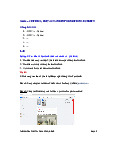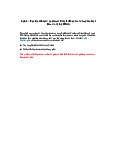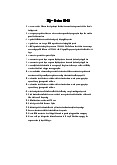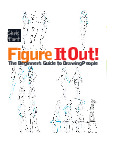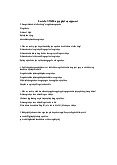













Preview text:
1 CHAPTER 1
Introduction to Financial Statements I/ Key Things to Know
The Purpose of Financial Accounting is to:
1) Record 2) Summarize, and 3) Report transactions of the company:
Transaction: an act that creates an exchange of something for something else
o provide a service or goods to a customer in exchange for cash
o purchase a delivery truck, pay cash for the truck o pay an employee for work
o pay the utility company for providing electricity
o receive money from the bank and agree to pay it back later
Most often the exchange is giving or receiving cash either now or in the future
Record: enter each transaction into a system - record what is increasing or decreasing
- use descriptive names for “accounts” to put things in categories
Summarize: net the impact of the increases and decreases for each item - “account”
The total of the “accounts” will be what you have and what you owe;
what you have earned from providing goods and services and what it
costs you to provide goods and services
Report: provide useful information to investors and creditors regarding cash
flows, resources (assets/have), and obligations (liabilities/owe).
4 Primary Financial Statements are used: o Balance Sheet o Income Statement
o Statement of Stockholder’s Equity o Statement of Cash Flows Report to: PH D. NGUYEN THANH NAM 2
Internal Users: managers who plan, organize and run the company
External Users: Investors who invest in the company
Creditors who loan money to the company Financial Statements:
Balance Sheet: States what your business owns (assets) and owes (liabilities) on a specific date.
Also shows the amount owned – assets less liabilities
Income Statement: Shows how much the business earned during a period of time.
This is what you have earned from providing goods and services
less what it costs you to provide goods and services
Statement of Shows the activity of shareholder’s (owners) during a period of time
Owner’s Equity Shows receipt of funds from shareholders and payments back to
shareholders in the form of dividends.
Shows the earnings of the business that go to the shareholders
(Some companies’ present a “statement of retained earnings”
Showing earnings and dividends paid only) Cash Flow
Statement: Shows the source of cash and what the cash was used for during
a period of time (Cash and Income are not the same)
What does each financial statement really tell you about the business?
Each statement has a heading that states the company name and the date or time period covered
Balance Sheet: What the company has and what they owe on a certain date PH D. NGUYEN THANH NAM 3
along with the ownership interest
Income Statement: How much the company earned during a specific period of time (monthly, quarterly, year)
Owner’s Equity: What occurred that impacted the owners of the company during a specific period of time
Cash Flows: How much cash was generated from day to day operations What the cash was used for
Where additional cash came from and how much was received
Additional Information on the Statement of Retained Earnings:
“Retained Earnings” is the amount of cumulative profits and losses kept by
the company since the first day of operations.
Retained earnings changes with net income (profits and losses) and dividends
paid to shareholders (owners) Beginning Retained Earnings + Net Income or - Net Loss - Dividends Paid = Ending Retained Earnings
Additional Information on the Statement of Cash Flows:
The cash flow statement has 3 separate sections:
Operating Activities: directly related earnings from day to day business operations
Investing Activities: directly related to buying and selling assets
used long term in the business
Financing Activities: directly related to borrowing and repaying debt PH D. NGUYEN THANH NAM 4
and receipts and payments from/to owners
“Elements” that are reported on financial statements
Asset: The company’s economic resources used to operate the business What the company HAS
1) Probable future economic benefit
2) Owned or controlled by the company
3) Resulting from a past transaction, something that has already occurred
The economic benefit is using the asset to generate future cash flows
or the asset itself will convert to cash
Liability: The company’s debts and obligations What the company OWES
1) Probable use of a future economic benefit (an asset) 2) Owed
3) Resulting from a past transaction
You will give up an asset to pay what you owe
Stockholder’s Equity: Earnings kept in the company / financing provided by the owners
1) Owner contributions to the company
2) Less dividends paid to owners
3) Plus profits and less losses, also called net income
Stockholder’s Equity is also equal to total assets less total liabilities
Revenues: Earned from providing goods or services in exchange for an asset.
This is the amount the customer is expected to pay for the goods or services they received
A revenue occurs when the good/service is provided to the customer PH D. NGUYEN THANH NAM 5
regardless of whether the customer has paid or not
Expenses: Using an asset of the company to provide goods or services
What it costs the company to provide the goods or services to the customer.
A service or good is provided to the company that the company
will have to pay for. The expense occurs when the company
receives the service or the asset is used up, not when the
company pays for the goods or service
Important: Revenues and expenses do not occur when the cash is received
or paid. They occur when the good or service is exchanged.
Revenues: the company gives the good or service
Expense: the company receives the service or uses up the asset
** Net Income (Revenues – Expenses) will not equal cash.
The Accounting Equation: Must always stay in balance
Assets = Liabilities + Stockholder’s Equity
Have = Owe + Own (Includes net profits) Revenues
What you have you owe for or own outright - Expenses Net profit or loss
Generally Accepted Accounting Principles “GAAP”: PH D. NGUYEN THANH NAM 6
Guidelines established by various accounting standard setting groups in consultation
with accounting professionals that give guidance on
1) What type of financial information must be provided
2) What format to use to provide information
3) How to measure assets, liabilities, revenues and expenses
“FASB” - Financial Accounting Standards Board
Is the primary accounting standards setting authority in the US
“IASB” – International Accounting Standards Board
Is the primary accounting standards setting authority for several countries outside of the US
“SEC” – Securities & Exchange Commission
The government agency that oversees US financial markets and
accounting standards for public companies
Financial statements that follow consistent guidelines are comparable
among companies and much easier to interpret for investors and creditors Footnotes:
Additional information provided after the financial statements 3 types of footnotes:
1) provides a description of the accounting rules followed
2) provides more details for the items listed on the financial statements
3) provides information on things not listed on the financial statements Auditor’s Report:
A professional accountant examines the company’s financial statements and gives a
report that determines if the statements are fairly stated in accordance with GAAP. PH D. NGUYEN THANH NAM 7
Q1. For each of the following items :
a./ Determine the financial statement the following accounts are reported on:
b./ state whether it is an asset (A), liability (L), Owner’s equity (O), revenue (R), or expense (E) at last a. inventory b. prepaid expenses c. sales d. cost of goods sold e. cash f. accounts payable g. accrued expenses h. cash from operations i. accounts receivable j. interest revenue k. notes payable l. dividends paid m. rent expense n. taxes payable o. accumulated depreciation
Q2. For each of the following items :
a./ Determine the financial statement the following accounts are reported on:
b./ state whether it is an asset (A), liability (L), Owner’s equity (O), revenue (R), or expense (E) ______1. Computers
______2. Amounts that customers owe the company ______3. Land ______4. Owe on account PH D. NGUYEN THANH NAM 8 ______5. Accrued expenses ______6. Retained earnings ______7. Trademarks ______8. Cost of goods sold
______9. Providing goods to customers
_____10. Salaries to employees _____11. Equipment _____12. Interest payable _____13. Owe the bank _____14,. Investments _____15. Common stock _____16. Advertising _____17. Cash _____18. Dividends paid
_____19. Items held to sell to customers
_____20. Providing services to customers
_____21. Prepaid insurance expense
Q3. A company had assets of $230,000 and liabilities of $145,000 at the beginning of the year.
During the year the company earned $45,000 and reduced what it owed by $22,000. What is total
assets at the end of the year? a. $185,000 b. $275,000 c. $253,000 d. $297,000
Q4. The company received bills for services provided to them during this month totaling $11,800
and paid bills this month totaling $13,600. What will be reported as expenses for this month? a. $13,600 PH D. NGUYEN THANH NAM 9 b. $11,800 c. $25,400 d. $ 1,800
Q5. The company provided goods to customers totaling $34,800 and collected payments from
customers this month in the amount of $39,200. What will be reported as revenues for this month? a. $39,200 b. $34,800 c. $74,000 d. $ 4,400
Q6. State whether each of the following is an asset (A), liability (L), stockholder’s equity (S),
revenue ( R), or an expense (E)
______1. Paid for advertising run this month.
______2. Amounts that the company owes for utilities ______3. Buildings
______4. Items held only to sell to a customer
______5. A customer pays for a service provided at the time it is provided
______6. Paying expenses before they are used ______7. Patents
______8. The cost of inventory that was sold to customers
______9. Total profits and losses for all periods
_____10. Earning interest on investments this period
Q7. During the first month of business the company had the following transactions:
1) issued stock to investors for $100,000
2) purchased inventory on account for $35,000
3) sold inventory that cost $29,000 to customers on account for $45,000
4) workers will be paid $10,000, they are paid the first of the following month PH D. NGUYEN THANH NAM 10
5) received the utility bill for $225
6) loaned a customer $10,000 to be repaid in 2 years
7) paid $30,000 for the inventory purchased on account
8) purchased computer equipment for $2,000 cash – recorded depreciation expense of $56 for the month
Require: Write double entry the transaction on above.
Q8. Review each of the following transactions and determine if the transaction will increase
(I) decrease (D) or have no effect (NA) on TOTAL ASSET of the company
Transaction: an act that creates an exchange of something for something else
a. provide a service or goods to a customer in exchange for cash
b. purchase a delivery truck, pay cash for the truck c. pay an employee for work
d. pay the utility company for providing electricity
e. receive money from the bank and agree to pay it back later
Q9. Review each of the following transactions and determine if the transaction will increase
(I) decrease (D) or have no effect (NA) on TOTAL LIABILITY of the company.
_______1. Borrow money from the bank
_______2. Pay cash for inventory to sell to the customers
_______3. Issue common stock to investors
_______4. Purchase a truck for company use, agree to a notes payable
_______5. Pay employees who worked this week
_______6. Receive the utility bill – it will be paid later
_______7. Sell goods to a customer on account
_______8. Pay for insurance for the next 6 months
_______9. Use cash to make an investment to be held long term
______10. Purchase the company’s own stock from investors PH D. NGUYEN THANH NAM
